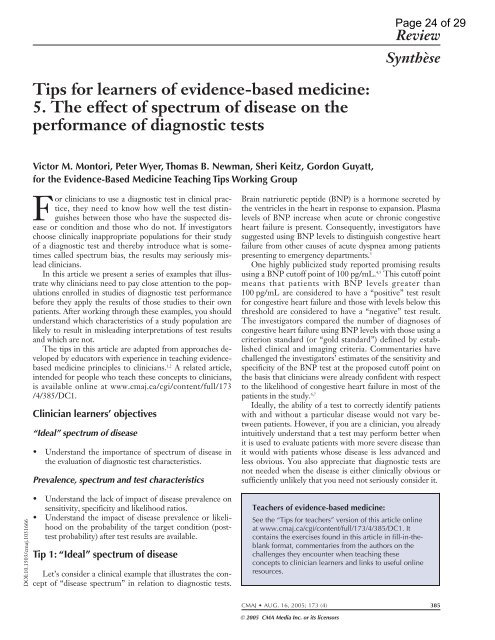Tips for Learners of Evidence-Based Medicine
Tips for Learners of Evidence-Based Medicine
Tips for Learners of Evidence-Based Medicine
You also want an ePaper? Increase the reach of your titles
YUMPU automatically turns print PDFs into web optimized ePapers that Google loves.
DOI:10.1503/cmaj.1031666<br />
<strong>Tips</strong> <strong>for</strong> learners <strong>of</strong> evidence-based medicine:<br />
5. The effect <strong>of</strong> spectrum <strong>of</strong> disease on the<br />
per<strong>for</strong>mance <strong>of</strong> diagnostic tests<br />
Victor M. Montori, Peter Wyer, Thomas B. Newman, Sheri Keitz, Gordon Guyatt,<br />
<strong>for</strong> the <strong>Evidence</strong>-<strong>Based</strong> <strong>Medicine</strong> Teaching <strong>Tips</strong> Working Group<br />
For clinicians to use a diagnostic test in clinical practice,<br />
they need to know how well the test distinguishes<br />
between those who have the suspected disease<br />
or condition and those who do not. If investigators<br />
choose clinically inappropriate populations <strong>for</strong> their study<br />
<strong>of</strong> a diagnostic test and thereby introduce what is sometimes<br />
called spectrum bias, the results may seriously mislead<br />
clinicians.<br />
In this article we present a series <strong>of</strong> examples that illustrate<br />
why clinicians need to pay close attention to the populations<br />
enrolled in studies <strong>of</strong> diagnostic test per<strong>for</strong>mance<br />
be<strong>for</strong>e they apply the results <strong>of</strong> those studies to their own<br />
patients. After working through these examples, you should<br />
understand which characteristics <strong>of</strong> a study population are<br />
likely to result in misleading interpretations <strong>of</strong> test results<br />
and which are not.<br />
The tips in this article are adapted from approaches developed<br />
by educators with experience in teaching evidencebased<br />
medicine principles to clinicians. 1,2 A related article,<br />
intended <strong>for</strong> people who teach these concepts to clinicians,<br />
is available online at www.cmaj.ca/cgi/content/full/173<br />
/4/385/DC1.<br />
Clinician learners’ objectives<br />
“Ideal” spectrum <strong>of</strong> disease<br />
• Understand the importance <strong>of</strong> spectrum <strong>of</strong> disease in<br />
the evaluation <strong>of</strong> diagnostic test characteristics.<br />
Prevalence, spectrum and test characteristics<br />
• Understand the lack <strong>of</strong> impact <strong>of</strong> disease prevalence on<br />
sensitivity, specificity and likelihood ratios.<br />
• Understand the impact <strong>of</strong> disease prevalence or likelihood<br />
on the probability <strong>of</strong> the target condition (posttest<br />
probability) after test results are available.<br />
Tip 1: “Ideal” spectrum <strong>of</strong> disease<br />
Let’s consider a clinical example that illustrates the concept<br />
<strong>of</strong> “disease spectrum” in relation to diagnostic tests.<br />
CMAJ • AUG. 16, 2005; 173 (4) 385<br />
© 2005 CMA Media Inc. or its licensors<br />
Review<br />
Synthèse<br />
Brain natriuretic peptide (BNP) is a hormone secreted by<br />
the ventricles in the heart in response to expansion. Plasma<br />
levels <strong>of</strong> BNP increase when acute or chronic congestive<br />
heart failure is present. Consequently, investigators have<br />
suggested using BNP levels to distinguish congestive heart<br />
failure from other causes <strong>of</strong> acute dyspnea among patients<br />
presenting to emergency departments. 3<br />
One highly publicized study reported promising results<br />
using a BNP cut<strong>of</strong>f point <strong>of</strong> 100 pg/mL. 4,5 This cut<strong>of</strong>f point<br />
means that patients with BNP levels greater than<br />
100 pg/mL are considered to have a “positive” test result<br />
<strong>for</strong> congestive heart failure and those with levels below this<br />
threshold are considered to have a “negative” test result.<br />
The investigators compared the number <strong>of</strong> diagnoses <strong>of</strong><br />
congestive heart failure using BNP levels with those using a<br />
criterion standard (or “gold standard”) defined by established<br />
clinical and imaging criteria. Commentaries have<br />
challenged the investigators’ estimates <strong>of</strong> the sensitivity and<br />
specificity <strong>of</strong> the BNP test at the proposed cut<strong>of</strong>f point on<br />
the basis that clinicians were already confident with respect<br />
to the likelihood <strong>of</strong> congestive heart failure in most <strong>of</strong> the<br />
patients in the study. 6,7<br />
Ideally, the ability <strong>of</strong> a test to correctly identify patients<br />
with and without a particular disease would not vary between<br />
patients. However, if you are a clinician, you already<br />
intuitively understand that a test may per<strong>for</strong>m better when<br />
it is used to evaluate patients with more severe disease than<br />
it would with patients whose disease is less advanced and<br />
less obvious. You also appreciate that diagnostic tests are<br />
not needed when the disease is either clinically obvious or<br />
sufficiently unlikely that you need not seriously consider it.<br />
Teachers <strong>of</strong> evidence-based medicine:<br />
See the “<strong>Tips</strong> <strong>for</strong> teachers” version <strong>of</strong> this article online<br />
at www.cmaj.ca/cgi/content/full/173/4/385/DC1. It<br />
contains the exercises found in this article in fill-in-theblank<br />
<strong>for</strong>mat, commentaries from the authors on the<br />
challenges they encounter when teaching these<br />
concepts to clinician learners and links to useful online<br />
resources.<br />
Page 24 <strong>of</strong> 29
















